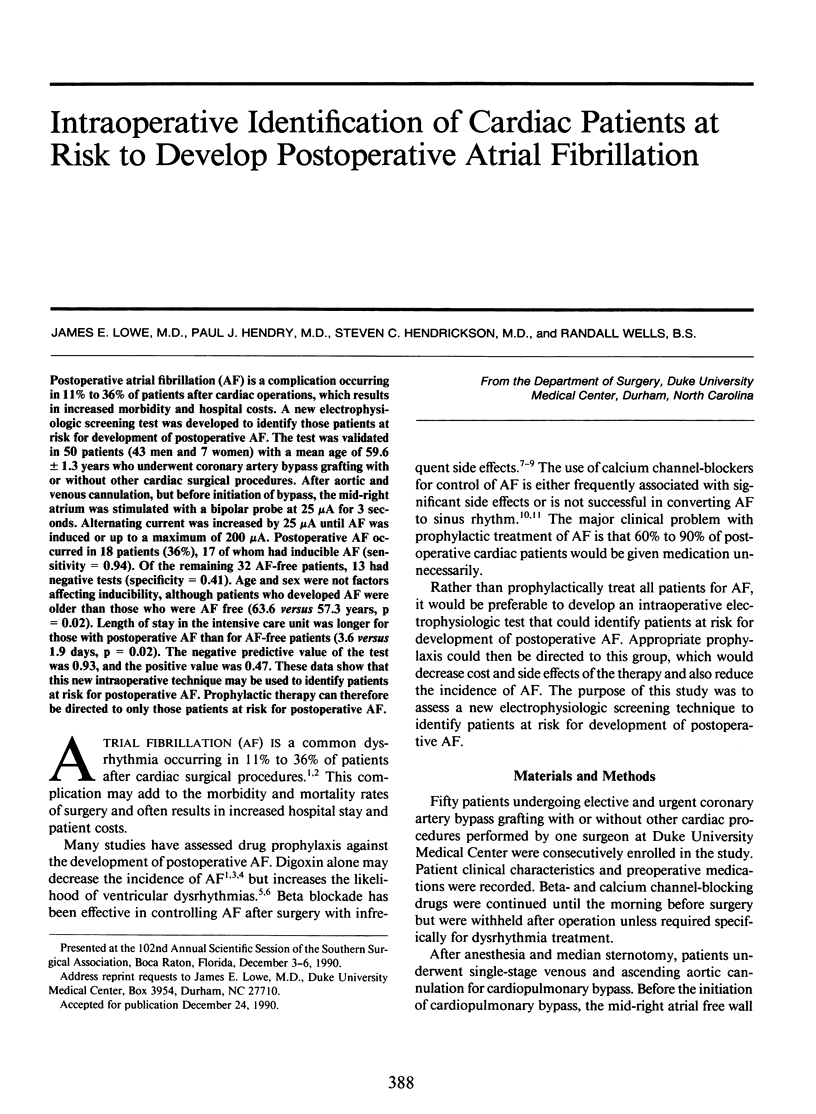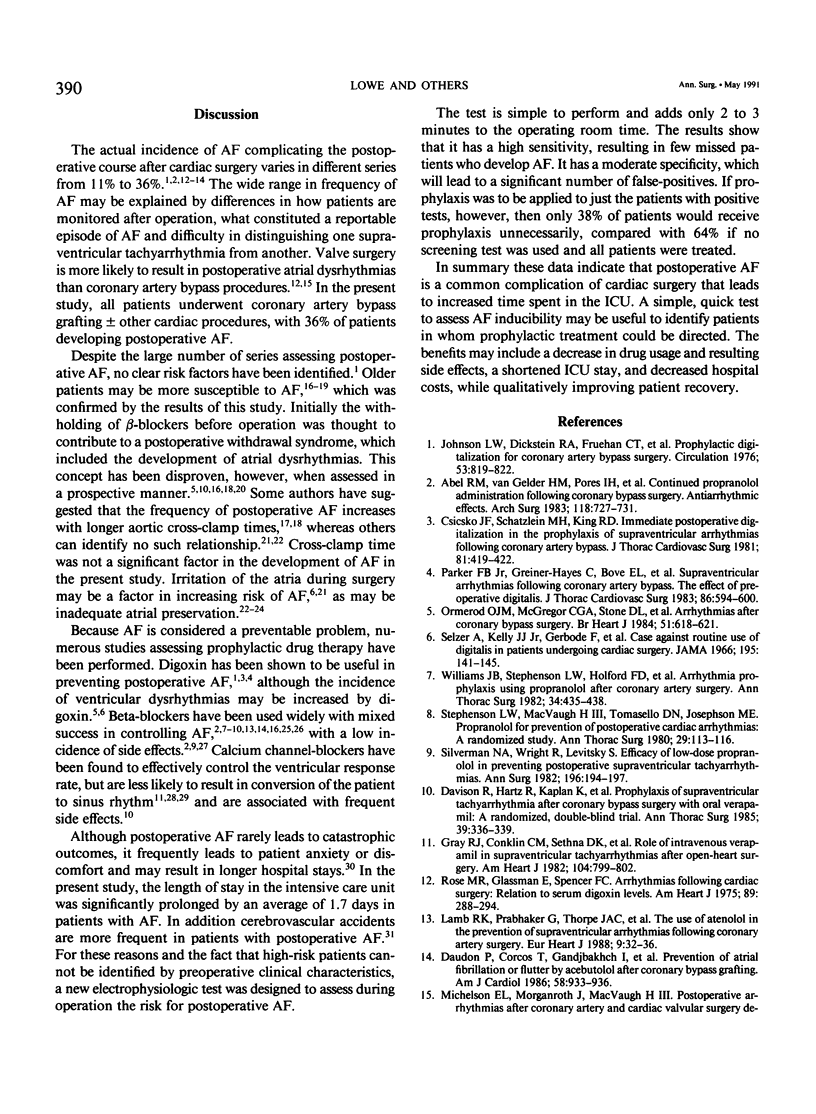Abstract
Postoperative atrial fibrillation (AF) is a complication occurring in 11% to 36% of patients after cardiac operations, which results in increased morbidity and hospital costs. A new electrophysiologic screening test was developed to identify those patients at risk for development of postoperative AF. The test was validated in 50 patients (43 men and 7 women) with a mean age of 59.6 +/- 1.3 years who underwent coronary artery bypass grafting with or without other cardiac surgical procedures. After aortic and venous cannulation, but before initiation of bypass, the mid-right atrium was stimulated with a bipolar probe at 25 microA for 3 seconds. Alternating current was increased by 25 microA until AF was induced or up to a maximum of 200 microA. Postoperative AF occurred in 18 patients (36%), 17 of whom had inducible AF (sensitivity = 0.94). Of the remaining 32 AF-free patients, 13 had negative tests (specificity = 0.41). Age and sex were not factors affecting inducibility, although patients who developed AF were older than those who were AF free (63.6 versus 57.3 years, p = 0.02). Length of stay in the intensive care unit was longer for those with postoperative AF than for AF-free patients (3.6 versus 1.9 days, p = 0.02). The negative predictive value of the test was 0.93, and the positive value was 0.47. These data show that this new intraoperative technique may be used to identify patients at risk for postoperative AF. Prophylactic therapy can therefore be directed to only those patients at risk for postoperative AF.
Full text
PDF



Selected References
These references are in PubMed. This may not be the complete list of references from this article.
- Abel R. M., van Gelder H. M., Pores I. H., Liguori J., Gielchinsky I., Parsonnet V. Continued propranolol administration following coronary bypass surgery. Antiarrhythmic effects. Arch Surg. 1983 Jun;118(6):727–731. doi: 10.1001/archsurg.1983.01390060045010. [DOI] [PubMed] [Google Scholar]
- Csicsko J. F., Schatzlein M. H., King R. D. Immediate postoperative digitalization in the prophylaxis of supraventricular arrhythmias following coronary artery bypass. J Thorac Cardiovasc Surg. 1981 Mar;81(3):419–422. [PubMed] [Google Scholar]
- Daudon P., Corcos T., Gandjbakhch I., Levasseur J. P., Cabrol A., Cabrol C. Prevention of atrial fibrillation or flutter by acebutolol after coronary bypass grafting. Am J Cardiol. 1986 Nov 1;58(10):933–936. doi: 10.1016/s0002-9149(86)80014-5. [DOI] [PubMed] [Google Scholar]
- Davison R., Hartz R., Kaplan K., Parker M., Feiereisel P., Michaelis L. Prophylaxis of supraventricular tachyarrhythmia after coronary bypass surgery with oral verapamil: a randomized, double-blind trial. Ann Thorac Surg. 1985 Apr;39(4):336–339. doi: 10.1016/s0003-4975(10)62626-4. [DOI] [PubMed] [Google Scholar]
- Fuller J. A., Adams G. G., Buxton B. Atrial fibrillation after coronary artery bypass grafting. Is it a disorder of the elderly? J Thorac Cardiovasc Surg. 1989 Jun;97(6):821–825. [PubMed] [Google Scholar]
- Gray R. J., Conklin C. M., Sethna D. H., Mandel W. J., Matloff J. M. Role of intravenous verapamil in supraventricular tachyarrhythmias after open-heart surgery. Am Heart J. 1982 Oct;104(4 Pt 1):799–802. doi: 10.1016/0002-8703(82)90014-x. [DOI] [PubMed] [Google Scholar]
- Hammon J. W., Jr, Wood A. J., Prager R. L., Wood M., Muirhead J., Bender H. W., Jr Perioperative beta blockade with propranolol: reduction in myocardial oxygen demands and incidence of atrial and ventricular arrhythmias. Ann Thorac Surg. 1984 Oct;38(4):363–367. doi: 10.1016/s0003-4975(10)62287-4. [DOI] [PubMed] [Google Scholar]
- Hwang M. H., Danoviz J., Pacold I., Rad N., Loeb H. S., Gunnar R. M. Double-blind crossover randomized trial of intravenously administered verapamil. Its use for atrial fibrillation and flutter following open heart surgery. Arch Intern Med. 1984 Mar;144(3):491–494. [PubMed] [Google Scholar]
- Ivey M. F., Ivey T. D., Bailey W. W., Williams D. B., Hessel E. A., 2nd, Miller D. W., Jr Influence of propranolol on supraventricular tachycardia early after coronary artery revascularization. A randomized trial. J Thorac Cardiovasc Surg. 1983 Feb;85(2):214–218. [PubMed] [Google Scholar]
- Johnson L. W., Dickstein R. A., Fruehan C. T., Kane P., Potts J. L., Smulyan H., Webb W. R., Eich R. H. Prophylactic digitalization for coronary artery bypass surgery. Circulation. 1976 May;53(5):819–822. doi: 10.1161/01.cir.53.5.819. [DOI] [PubMed] [Google Scholar]
- Lamb R. K., Prabhakar G., Thorpe J. A., Smith S., Norton R., Dyde J. A. The use of atenolol in the prevention of supraventricular arrhythmias following coronary artery surgery. Eur Heart J. 1988 Jan;9(1):32–36. [PubMed] [Google Scholar]
- Leitch J. W., Thomson D., Baird D. K., Harris P. J. The importance of age as a predictor of atrial fibrillation and flutter after coronary artery bypass grafting. J Thorac Cardiovasc Surg. 1990 Sep;100(3):338–342. [PubMed] [Google Scholar]
- Matangi M. F., Neutze J. M., Graham K. J., Hill D. G., Kerr A. R., Barratt-Boyes B. G. Arrhythmia prophylaxis after aorta-coronary bypass. The effect of minidose propranolol. J Thorac Cardiovasc Surg. 1985 Mar;89(3):439–443. [PubMed] [Google Scholar]
- Michelson E. L., Morganroth J., MacVaugh H., 3rd Postoperative arrhythmias after coronary artery and cardiac valvular surgery detected by long-term electrocardiographic monitoring. Am Heart J. 1979 Apr;97(4):442–448. doi: 10.1016/0002-8703(79)90390-9. [DOI] [PubMed] [Google Scholar]
- Mohr R., Smolinsky A., Goor D. A. Prevention of supraventricular tachyarrhythmia with low-dose propranolol after coronary bypass. J Thorac Cardiovasc Surg. 1981 Jun;81(6):840–845. [PubMed] [Google Scholar]
- Ormerod O. J., McGregor C. G., Stone D. L., Wisbey C., Petch M. C. Arrhythmias after coronary bypass surgery. Br Heart J. 1984 Jun;51(6):618–621. doi: 10.1136/hrt.51.6.618. [DOI] [PMC free article] [PubMed] [Google Scholar]
- Parker F. B., Jr, Greiner-Hayes C., Bove E. L., Marvasti M. A., Johnson L. W., Eich R. H. Supraventricular arrhythmias following coronary artery bypass. The effect of preoperative digitalis. J Thorac Cardiovasc Surg. 1983 Oct;86(4):594–600. doi: 10.1016/0022-460x(83)91023-4. [DOI] [PubMed] [Google Scholar]
- Plumb V. J., Karp R. B., Kouchoukos N. T., Zorn G. L., Jr, James T. N., Waldo A. L. Verapamil therapy of atrial fibrillation and atrial flutter following cardiac operation. J Thorac Cardiovasc Surg. 1982 Apr;83(4):590–596. [PubMed] [Google Scholar]
- Roffman J. A., Fieldman A. Digoxin and propranolol in the prophylaxis of supraventricular tachydysrhythmias after coronary artery bypass surgery. Ann Thorac Surg. 1981 Jun;31(6):496–501. doi: 10.1016/s0003-4975(10)61337-9. [DOI] [PubMed] [Google Scholar]
- Rose M. R., Glassman E., Spencer F. C. Arrhythmias following cardiac surgery: relation to serum digoxin levels. Am Heart J. 1975 Mar;89(3):288–294. doi: 10.1016/0002-8703(75)90077-0. [DOI] [PubMed] [Google Scholar]
- Rubin D. A., Nieminski K. E., Reed G. E., Herman M. V. Predictors, prevention, and long-term prognosis of atrial fibrillation after coronary artery bypass graft operations. J Thorac Cardiovasc Surg. 1987 Sep;94(3):331–335. [PubMed] [Google Scholar]
- Silverman N. A., Wright R., Levitsky S. Efficacy of low-dose propranolol in preventing postoperative supraventricular tachyarrhythmias: a prospective, randomized study. Ann Surg. 1982 Aug;196(2):194–197. doi: 10.1097/00000658-198208000-00012. [DOI] [PMC free article] [PubMed] [Google Scholar]
- Smith P. K., Buhrman W. C., Levett J. M., Ferguson T. B., Jr, Holman W. L., Cox J. L. Supraventricular conduction abnormalities following cardiac operations. A complication of inadequate atrial preservation. J Thorac Cardiovasc Surg. 1983 Jan;85(1):105–115. [PubMed] [Google Scholar]
- Stephenson L. W., MacVaugh H., 3rd, Tomasello D. N., Josephson M. E. Propranolol for prevention of postoperative cardiac arrhythmias: a randomized study. Ann Thorac Surg. 1980 Feb;29(2):113–116. doi: 10.1016/s0003-4975(10)61647-5. [DOI] [PubMed] [Google Scholar]
- Taylor G. J., Malik S. A., Colliver J. A., Dove J. T., Moses H. W., Mikell F. L., Batchelder J. E., Schneider J. A., Wellons H. A. Usefulness of atrial fibrillation as a predictor of stroke after isolated coronary artery bypass grafting. Am J Cardiol. 1987 Oct 1;60(10):905–907. doi: 10.1016/0002-9149(87)91045-9. [DOI] [PubMed] [Google Scholar]
- Tchervenkov C. I., Wynands J. E., Symes J. F., Malcolm I. D., Dobell A. R., Morin J. E. Electrical behavior of the heart following high-potassium cardioplegia. Ann Thorac Surg. 1983 Sep;36(3):314–319. doi: 10.1016/s0003-4975(10)60134-8. [DOI] [PubMed] [Google Scholar]
- Tchervenkov C. I., Wynands J. E., Symes J. F., Malcolm I. D., Dobell A. R., Morin J. E. Persistent atrial activity during cardioplegic arrest: a possible factor in the etiology of postoperative supraventricular tachyarrhythmias. Ann Thorac Surg. 1983 Oct;36(4):437–443. doi: 10.1016/s0003-4975(10)60484-5. [DOI] [PubMed] [Google Scholar]
- Williams D. B., Misbach G. A., Kruse A. P., Ivey T. D. Oral verapamil for prophylaxis of supraventricular tachycardia after myocardial revascularization. A randomized trial. J Thorac Cardiovasc Surg. 1985 Oct;90(4):592–596. [PubMed] [Google Scholar]
- Williams J. B., Stephensen L. W., Holford F. D., Langer T., Dunkman W. B., Josephson M. E. Arrhythmia prophylaxis using propranolol after coronary artery surgery. Ann Thorac Surg. 1982 Oct;34(4):435–438. doi: 10.1016/s0003-4975(10)61406-3. [DOI] [PubMed] [Google Scholar]


